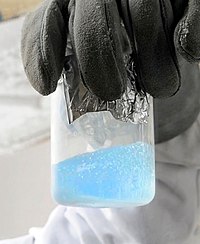
Photo from wikipedia
Future energy demands for green hydrogen have fueled intensive research on proton‐exchange membrane water electrolyzers (PEMWE). However, the sluggish oxygen evolution reaction (OER) and highly corrosive environment on the anode… Click to show full abstract
Future energy demands for green hydrogen have fueled intensive research on proton‐exchange membrane water electrolyzers (PEMWE). However, the sluggish oxygen evolution reaction (OER) and highly corrosive environment on the anode side narrow the catalysts to be expensive Ir‐based materials. It is very challenging to develop cheap and effective OER catalysts. Herein, Co‐hexamethylenetetramine metal–organic framework (Co‐HMT) as the precursor and a fast‐quenching method is employed to synthesize RuO2 nanorods loaded on antimony‐tin oxide (ATO). Physical characterizations and theoretical calculations indicate that the ATO can increase the electrochemical surface areas of the catalysts, while the tensile strains incorporated by quenching can alter the electronic state of RuO2. The optimized catalyst exhibits a small overpotential of 198 mV at 10 mA cm−2 for OER, and keeps almost unchanged after 150 h chronopotentiometry. When applied in a real PEMWE assembly, only 1.51 V is needed for the catalyst to reach a current density of 1 A cm−2.
Journal Title: Advanced Science
Year Published: 2022
Link to full text (if available)
Share on Social Media: Sign Up to like & get
recommendations!